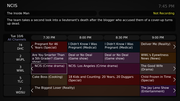NTSC-J or "System J" is the informal designation for the analogue television standard used in Japan. The system is based on the US NTSC (NTSC-M) standard...
11 KB (1,279 words) - 07:32, 7 September 2024
1961, it was assigned the designation System M. It is also known as EIA standard 170. In 1953, a second NTSC standard was adopted, which allowed for color...
86 KB (10,167 words) - 14:18, 9 September 2024
by the Federal Communications Commission (FCC) under the NTSC system on July 1, 1941. Channel 1 was located at 50–56 MHz, with visual carrier at 51.25 MHz...
16 KB (2,178 words) - 09:30, 23 January 2024
in North America, channel 2 refers to the terrestrial or cable band of 54 to 60 MHz, with carrier frequencies of 55.25 MHz for NTSC analog video (VSB)...
9 KB (952 words) - 23:47, 13 July 2024
PAL (section PAL vs. NTSC)
system for analog television. It was one of three major analogue colour television standards, the others being NTSC and SECAM. In most countries it was...
60 KB (6,475 words) - 22:22, 9 September 2024
a ban on Channel 37. The Bahamas has a similar ban to Canada's on Channel 37. Belize has an absolute ban on Channel 37. Most NTSC System-M countries...
15 KB (1,644 words) - 16:02, 12 March 2024
FM band). This required a reassignment of the VHF channels to the plan currently in use. System M 525 lines (most countries in the Americas and Caribbean...
51 KB (2,007 words) - 01:59, 5 September 2024
PAL television, as do NTSC signals. PAL-M Details: Transmission band: VHF/UHF Fields: 60 Scan lines: 525 Active lines: 480 Channel bandwidth: 6 MHz Video...
10 KB (1,089 words) - 07:32, 7 September 2024
Multichannel television sound NTSC NTSC-J PAL RCA SECAM Moving image formats Early television stations Knife-edge effect Channel 37 North American broadcast...
11 KB (160 words) - 04:43, 17 May 2024
color system used (NTSC, PAL, and SECAM), but purely monochrome signals can also be used. A composite video signal combines, on one wire, the video information...
15 KB (1,647 words) - 04:00, 18 August 2024



